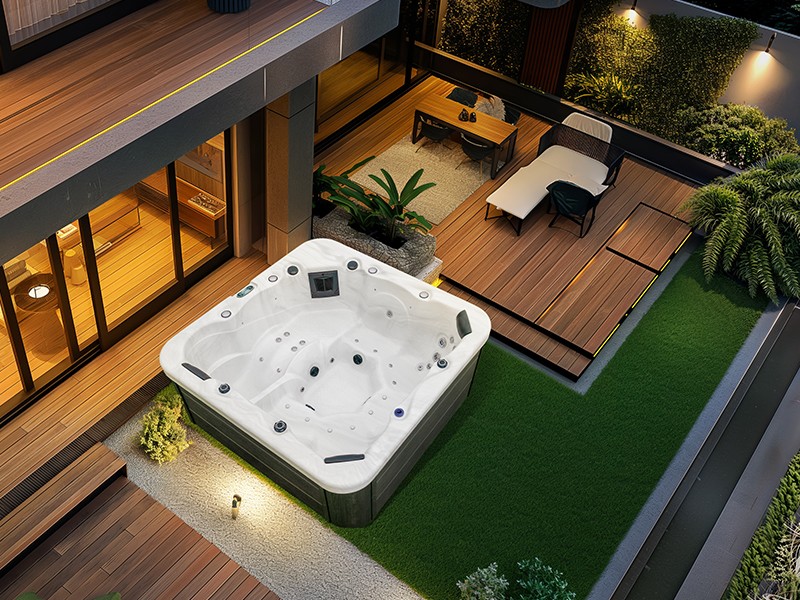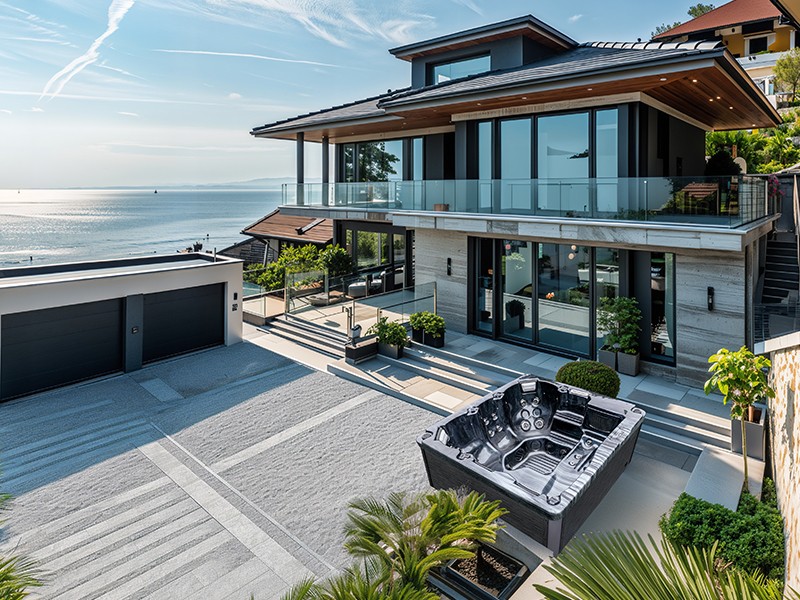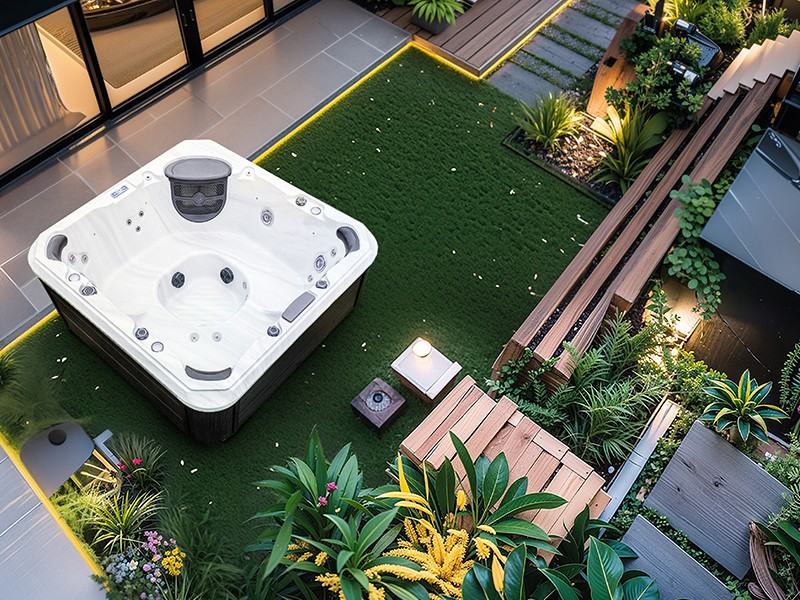
Jak často by se venkovní vířivka měla vypouštět a znovu napouštět?
2024-11-07 15:35Se změnou ročních období, zejména v létě a v zimě, mohou extrémní změny okolní teploty ovlivnit kvalitu vody ve vaně. V horkém létě se doporučuje zkrátit vypouštěcí cyklus z důvodu zrychleného růstu bakterií, zatímco v chladné zimě, i když je růst bakterií pomalejší, může změna venkovního prostředí přesto způsobit zhoršení kvality vody. Sezónní úprava frekvence odvodňování je proto důležitým prostředkem k zajištění kvality vody.Jaké jsou konkrétní kroky pro vypouštění a napouštění vody?Poté, co pochopíte, kdy vypustit, je nezbytné zvládnout správné kroky vypouštění a plnění
masážní vana
v dobrém stavu. Zde je podrobný návod krok za krokem:
Vypusťte dřez
● Vypněte napájení: Před vypuštěním vždy vypněte napájení masážní vany, abyste předešli riziku úrazu elektrickým proudem.
● Připojte odtokovou trubku: Připojte odtokovou trubku k odtokovému výstupu masážní vany, abyste zajistili, že voda může hladce odtékat do odtokové oblasti.
● Vypusťte umyvadlo: Otevřete vypouštěcí ventil a zcela vypusťte vodu ve vaně. Aby se zabránilo zbytkům nečistot, doporučuje se použít hadici k úplnému vypuštění zbývající vody.
Vyčistěte vnitřní povrch vany
● Použití mycího prostředku: Po vypuštění dřezu otřete vnitřní povrch vany speciálním čističem na vanu, abyste odstranili nečistoty a zbytky. Vyhněte se používání čisticích prostředků obsahujících agresivní chemikálie, aby nedošlo k poškození materiálu vany.
● Vyčistěte filtr: Před doplňováním nezapomeňte zkontrolovat a vyčistit filtr, abyste se ujistili, že není ucpaný a funguje správně.
Doplňování
● Pomalé plnění: Po vyprázdnění a vyčištění můžete začít s plněním. Doporučuje se používat pomalý proud vody, aby nadměrný tlak vody nepoškodil vnitřní systém vany.
● Zkontrolujte teplotu a kvalitu vody: Po naplnění vodou otestujte pomocí testovacího nástroje teplotu vody a kvalitu vody, abyste se ujistili, že hodnota pH a koncentrace dezinfekčního prostředku ve vodě jsou v rozumném rozmezí.
Environmental influences
Outdoor whirlpool tubs are exposed to the elements and can be contaminated by impurities in the air, such as dust, pollen, and leaves. These impurities can enter the water, causing the water quality to deteriorate. In addition, changes in outdoor temperature can also affect the cleanliness of the water. In hot environments, bacteria grow faster, and water quality can deteriorate rapidly, especially in the summer.
● Weather conditions: Storms, fallen tree debris, etc. can affect the water quality in the tub, resulting in frequent cleaning and draining needs.
● Sand and dust: If you live in a windy or dusty area, the water quality of your tub will be affected more quickly by external contaminants.
Effectiveness of water treatment systems
Many modern outdoor whirlpool tubs are equipped with water treatment systems, such as ozone generators, filters, and chemical additives, which help keep the water clean. However, the effectiveness of these systems will decline over time, especially the filters need to be cleaned and replaced regularly, otherwise the water quality will not be effectively maintained.
● Filter condition: Filters are an important part of keeping water clean, but if the filters are not cleaned for a long time, they will become a source of pollution, causing the water quality to deteriorate rapidly.
● Maintenance of water treatment systems: Even if efficient water treatment equipment is installed, it cannot prevent the water quality from deteriorating if it is not maintained or replaced on time. Therefore, in addition to emptying and filling water, maintaining the equipment is also key to ensuring water quality.
Chemical balance in water
The water quality of outdoor massage bathtubs is also affected by chemical balance. Fluctuations in pH and alkalinity will directly affect the chemical reactions in the water. Water that is too acidic or alkaline may cause the chemicals in the water to fail, thereby affecting the water quality. At the same time, excessive or insufficient use of chemicals will also have a negative impact on water quality.
● pH monitoring: The ideal pH value should be maintained between 7.2 and 7.8. Too high or too low pH values will affect the effectiveness of chemicals in the water.
● Chlorine and ozone concentrations: Maintaining the right disinfectant concentration is essential to inhibit bacterial growth, but too much of the chemical can have a negative impact on the skin and bathtub materials.
What is the optimal frequency for draining and refilling an outdoor whirlpool tub?
Knowing the main factors that affect water quality, we can determine that the frequency of draining an outdoor whirlpool tub should be determined on a case-by-case basis. Here are some general recommendations:
Drain every three months
For most home outdoor whirlpool tubs, experts generally recommend draining and refilling every three months. This time frame is suitable for a bathtub with normal frequency of use, which can effectively maintain healthy water quality and prevent bacterial growth. If your bathtub is equipped with a good filtration system and disinfection equipment, and the environment is relatively clean, this frequency can usually maintain stable water quality.
● Applicable conditions: A whirlpool tub suitable for use by a single person or a small number of family members, and the bathtub is equipped with a regularly maintained water treatment system.
● Exceptions: In extreme weather or frequent use, a three-month drain cycle may not be enough to maintain water quality, and the drain cycle needs to be shortened.
Check water quality monthly
Although a three-month drain cycle is more common, it is recommended to regularly check the water's pH, alkalinity, and disinfectant concentration monthly to ensure healthy water quality. This can help you understand whether the chemical balance in the water is normal and prevent possible water quality issues.
● Water quality testing tools: Use water quality test strips or test kits to perform a detailed water quality analysis once a month to ensure that the pH and disinfectant concentration are within the ideal range. If the water quality is found to deviate from the normal range, take immediate measures to adjust or drain and replace it.
Frequent use by multiple people requires more frequent draining
If your whirlpool bathtub is often used for social gatherings or shared by multiple people, contaminants in the water can increase rapidly. In this case, it is recommended to empty and refill the water every 1 to 2 months, or even more frequently, to ensure clean water quality.
● Treatment after multiple people use: It is recommended to clean the bathtub and add new water after each multiple-person use. Although it does not necessarily need to be completely drained, new water can be added regularly and chemically treated to keep the water quality stable.
Seasonal adjustments
As the seasons change, especially in summer and winter, extreme changes in ambient temperature can affect the quality of the bathtub water. In the hot summer, it is recommended to shorten the drain cycle due to the accelerated bacterial growth, while in the cold winter, although the bacterial growth is slower, the change of outdoor environment may still cause the water quality to deteriorate. Therefore, seasonal adjustment of the drainage frequency is an important means to ensure water quality.
What are the specific steps for draining and filling water?
After understanding when to drain, mastering the correct drainage and filling steps is essential to keep the massage bathtub in good condition. Here is a detailed step-by-step guide:
Drain the sink
● Turn off the power: Before draining, always turn off the power of the massage bathtub to avoid the risk of electric shock.
● Connect the drain pipe: Connect the drain pipe to the drain outlet of the massage bathtub to ensure that the water can be discharged smoothly to the drain area.
● Drain the sink: Open the drain valve and completely drain the water in the bathtub. To prevent contaminants from remaining, it is recommended to use a hose to completely drain the remaining water.
Clean the inner surface of the bathtub
● Detergent use: After draining the sink, wipe the inner surface of the bathtub with a special bathtub cleaner to remove dirt and residue. Avoid using detergents containing harsh chemicals to prevent damage to the bathtub material.
● Clean the filter: Before refilling, be sure to check and clean the filter to ensure it is not clogged and is working properly.
Refilling
● Slow filling: After emptying and cleaning, you can start filling. It is recommended to use a slow water flow to prevent excessive water pressure from damaging the internal system of the bathtub.
● Check water temperature and water quality: After filling with water, use a test tool to test the water temperature and water quality to ensure that the pH value and disinfectant concentration of the water are within a reasonable range.
Sezónní úpravy



